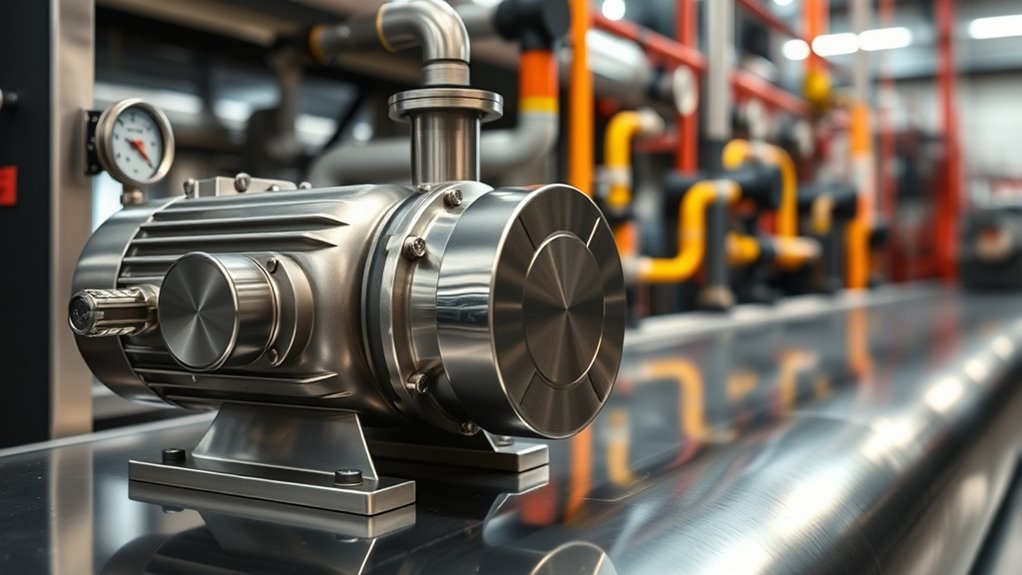To guarantee a silent, smooth overflow, you need to correctly size your pump based on your system’s flow requirements and head pressure. Avoid undersizing, which can cause turbulence, noise, and cavitation, or oversizing, which wastes energy and increases vibrations. Choose a high-efficiency pump with features like variable speed drives for better control and quieter operation. Proper installation and routine maintenance also play key roles, helping you maintain peak performance over time. Continue to explore for more tips to perfect your setup.
Key Takeaways
- Measure the required flow rate to ensure steady, silent overflow without turbulence or cavitation.
- Select a pump with appropriate capacity to balance adequate flow and minimize noise.
- Use high-efficiency pumps with variable speed drives for real-time flow adjustments and quieter operation.
- Ensure proper installation with correct pipe alignment, tight fittings, and vibration isolation to reduce noise.
- Perform regular maintenance and use sound-dampening materials to sustain smooth, silent overflow performance.

Choosing the right pump size is essential for ensuring efficient system performance and minimizing energy costs. When you select a pump that’s appropriately sized, you not only improve energy efficiency but also reduce operational noise, creating a quieter environment around your system. An undersized pump struggles to meet flow demands, forcing it to run at higher speeds and consume more electricity, which spikes your energy bills. Conversely, an oversized pump wastes power by operating below capacity, leading to unnecessary energy consumption and potential wear on components. Getting the size right balances performance with cost savings, helping your system run smoothly and reliably.
Choosing the right pump size ensures efficient, quiet, and reliable system performance while minimizing energy costs.
To achieve this balance, you need to carefully assess your system’s flow requirements and head pressure. Measure the flow rate needed to maintain a steady, silent overflow—anything too high can cause turbulence and noise, while too low can result in inconsistent flow or cavitation. Proper sizing ensures the pump provides just enough flow without creating excessive noise, which is critical for maintaining a peaceful environment. Noise reduction is directly linked to selecting a pump with the right capacity; a well-sized pump runs more smoothly, producing less vibration and sound. This quiet operation makes your system less intrusive and more pleasant to be around, especially in residential or sensitive commercial settings.
Another important aspect is selecting a pump with good energy efficiency ratings. Pumps with high efficiency convert more electrical energy into hydraulic energy, reducing waste and lowering your energy costs. When you choose a pump designed for maximum performance at your required flow rate, you avoid the pitfalls of high energy consumption and excessive heat generation. Many modern pumps come with variable speed drives, allowing you to fine-tune the flow based on real-time needs. This adaptability not only enhances energy efficiency but also minimizes noise, as the pump operates at lower speeds when full capacity isn’t necessary. Such features help you achieve a quieter, more economical system that performs consistently.
Additionally, proper installation and regular maintenance further improve energy efficiency and noise reduction. Ensuring pipes are correctly aligned, fittings are tight, and any air is purged from the system prevents undue strain on the pump. Routine checks for wear and lubrication help keep the pump operating smoothly, preventing vibrations that can amplify noise. When you pay attention to these details, you extend the lifespan of your pump, reduce energy costs, and maintain a peaceful, efficient overflow system. Incorporating sound-dampening materials and vibration isolation techniques can further enhance noise reduction efforts. Overall, choosing the right size isn’t just about meeting flow needs—it’s about creating a balanced, quiet, and energy-efficient system that works seamlessly over time.
Frequently Asked Questions
How Do I Choose the Right Pump for Varying Water Flow?
To choose the right pump for varying water flow, you need to prioritize pump efficiency and flow control. Start by evaluating your flow requirements and select a pump that can adapt to fluctuating demands without sacrificing efficiency. Look for models with adjustable flow control features, which allow you to fine-tune performance. This ensures smooth operation, minimizes energy use, and prevents overflows or dry running issues.
What Are the Signs of an Undersized or Oversized Pump?
If your pump makes excessive noise or you notice flow inconsistency, it might be undersized or oversized. An undersized pump often struggles to maintain steady flow, causing it to work harder and produce more noise. Conversely, an oversized pump can cause turbulent flow, leading to vibration and instability. Pay attention to these signs, and modify your pump size accordingly to guarantee smooth, silent operation and consistent water flow.
How Does Pipe Material Affect Pump Performance?
Imagine your pump struggling because of pipe material choices. You might not realize that pipe corrosion increases flow resistance, which forces your pump to work harder. Smooth performance depends on selecting corrosion-resistant materials like PVC or stainless steel. These materials reduce flow resistance, ensuring steady flow and preventing pressure drops. Choosing the right pipe material keeps your pump efficient, prolongs its lifespan, and maintains silent, smooth overflow operation.
Can Solar Power Be Used for Pump Operation?
Yes, you can use solar energy for pump operation, but you need to ensure pump compatibility. Not all pumps are designed for solar power, so check if the pump is compatible with direct solar connection or requires an inverter. You also need to take into account the power requirements and sunlight availability in your area. If you choose the right solar-powered system, you’ll enjoy eco-friendly, cost-effective operation that reduces reliance on grid power.
What Maintenance Is Required for Long-Term Pump Efficiency?
To keep your pump running efficiently long-term, you should regularly check and perform pump lubrication to reduce wear and prevent overheating. Additionally, clean filters consistently to prevent debris buildup, which can impair performance. Inspect the pump for any signs of corrosion or leaks, and ensure all components are properly maintained. Routine maintenance like these keeps your pump operating smoothly, prolongs its lifespan, and maintains ideal overflow silencing.
Conclusion
Now that you’ve mastered pump sizing, imagine your system running so smoothly, it’s like a ballet of silent, graceful dancers—except they’re pipes and valves, not pirouetting prima donnas. With the right pump, your overflow will whisper rather than roar, turning chaos into calm. So go ahead, pick that perfect pump and watch your system perform a flawless, quiet ballet—no prima donnas, just pure, serene flow.









